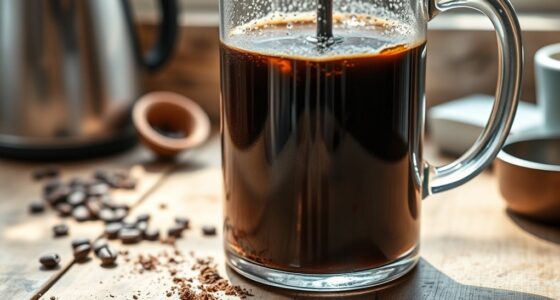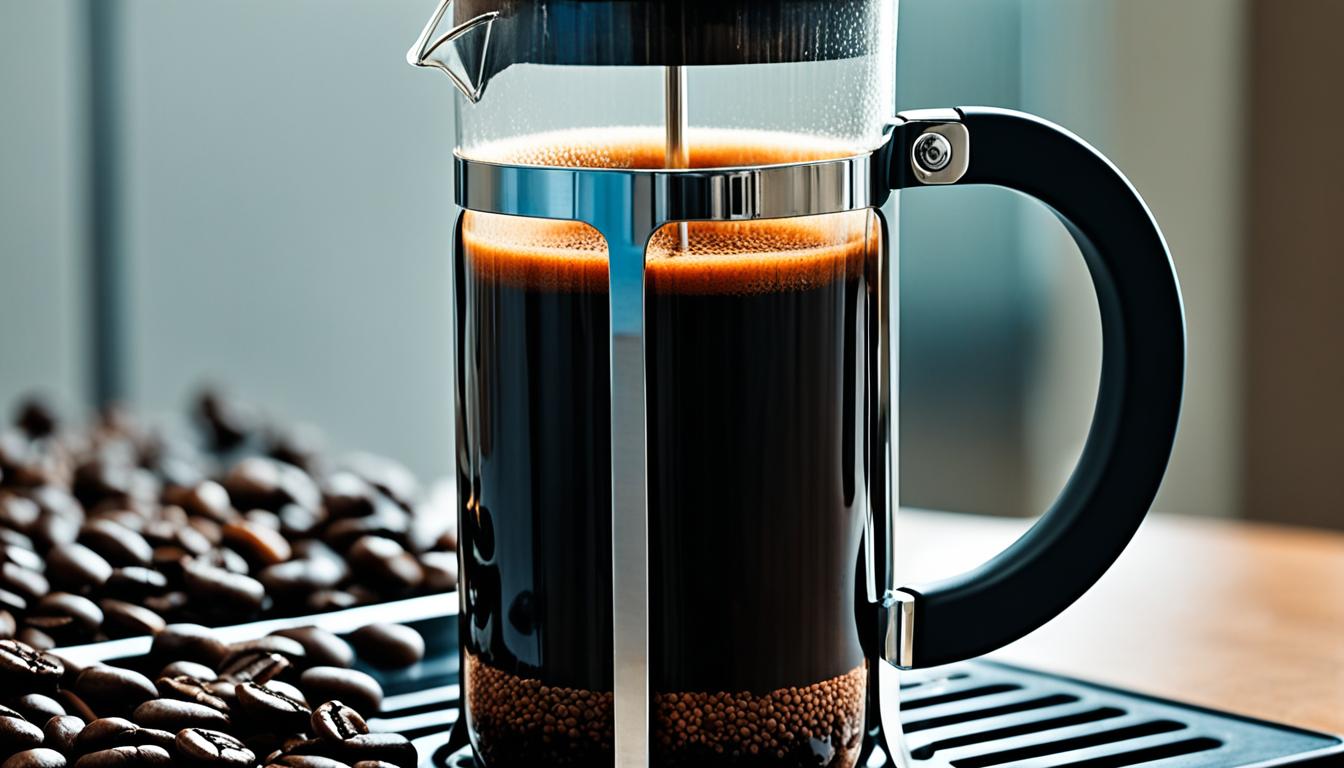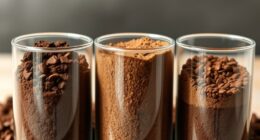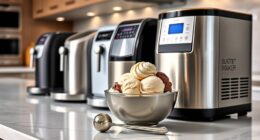Finding your perfect French press ratio starts with experimenting around 1:15 to 1:17 coffee to water. Use a consistent grind size, ideally coarse, and keep your brew temperature between 195°F to 205°F for best flavor. Adjust these variables gradually to suit your taste, aiming for a balanced blend of richness and clarity. If you keep tweaking, you’ll discover the ideal ratio that brings out the full potential of your brew, and there’s more to explore below.
Key Takeaways
- Use a coffee-to-water ratio of 1:15 to 1:17 for balanced extraction in French press brewing.
- Adjust grind size to coarse for optimal extraction; too fine can cause over-extraction and bitterness.
- Maintain water temperature between 195°F and 205°F to enhance flavor and prevent over- or under-extraction.
- Consistently use uniform grind particles to ensure even extraction and consistent flavor profiles.
- Fine-tune ratios, grind size, and temperature based on taste preferences for your ideal brew strength.
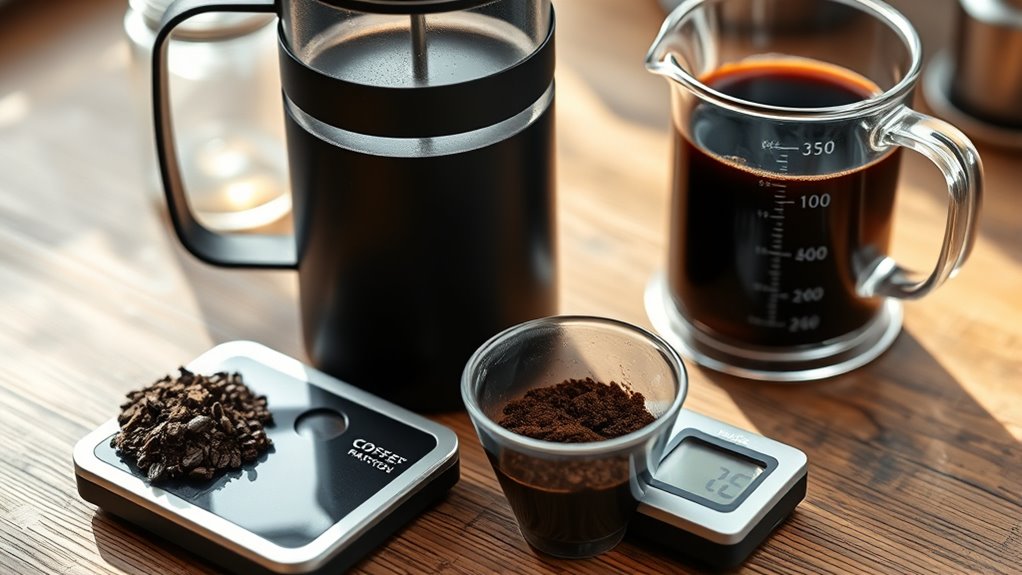
A perfect cup of French press coffee starts with the right ratio of coffee to water. But even with the perfect ratio, other factors like brew temperature and grind consistency influence the final flavor. Achieving a balanced and flavorful brew depends on paying attention to these details. First, consider brew temperature. Ideally, you want your water between 195°F and 205°F—just below boiling point. Too hot, and you’ll risk over-extracting bitter compounds; too cool, and you’ll under-extract, resulting in a weak, sour taste. Maintaining this temperature range ensures maximum extraction of coffee oils and flavors, giving you a richer, more nuanced cup. Using a thermometer can help you hit that sweet spot consistently, especially if you’re brewing multiple times or in different environments. Interestingly, recent AI discoveries have shown that manipulating variables like temperature can unlock new levels of flavor and extraction efficiency in brewing.
Next, pay close attention to grind consistency. This is vital because the size of your coffee grounds impacts extraction time and flavor. For French press, a coarse grind works best—think roughly the consistency of sea salt. If your grind is too fine, it can slip through the mesh filter and cause over-extraction, leading to a muddy or bitter brew. Conversely, if it’s too coarse, water may pass through too quickly, resulting in a weak or under-extracted coffee. To get the grind right, consider investing in a burr grinder rather than blade grinders, as they produce more uniform particles. Consistent grind size ensures even extraction, which is key to balancing the flavors and avoiding over- or under-extraction. Grind consistency is also a factor that can be optimized through precise control over grinding methods.
Combining the right brew temperature with a consistent grind size allows you to better control the extraction process. When you start with a proper coffee-to-water ratio—usually about 1:15 to 1:17—you set a solid foundation. Then, adjust your grind and temperature to fine-tune the flavor. For example, if your coffee tastes flat or weak, try slightly increasing the temperature or using a finer grind, but always stay within ideal ranges. If it’s too bitter or over-extracted, lower the temperature or opt for a coarser grind. Mastering these variables can be enhanced by the latest AI-driven insights into optimal brewing conditions.
In essence, mastering French press ratios isn’t just about measuring coffee and water; it’s about understanding how brew temperature and grind consistency work together to influence extraction. When you dial these variables in, you’ll find your perfect brew — rich, balanced, and full of flavor. Consistency and attention to detail are what turn a good cup into a great one.
Frequently Asked Questions
How Does Grind Size Affect the Ideal French Press Ratio?
Your grind size directly impacts the ideal French press ratio because it affects extraction balance. A coarser grind usually requires a higher coffee-to-water ratio to prevent under-extraction, while a finer grind promotes quicker extraction, so you might lower the ratio. Adjusting the ratio based on grind size helps you achieve a balanced brew, ensuring it’s not too weak or too bitter. Play with ratios to find what works best for your preferred grind.
Can Different Coffee Beans Require Different Ratios?
Different coffee beans do require different ratios, just like adjusting a recipe for a richer cake or lighter souffle. For example, beans with bold flavor profiles, like dark roasts, might need a higher coffee-to-water ratio to highlight their intensity, while delicate beans with subtle notes benefit from a more balanced ratio. Understanding bean characteristics helps you customize your French press brew for ideal flavor, making each cup uniquely satisfying.
What Adjustments Are Needed for Brewing Iced French Press Coffee?
To brew iced French press coffee, lower the water temperature slightly and extend the brew time to about 4 minutes. Use hot water, around 195°F to 205°F, then pour over ice after brewing to prevent over-extraction. Stir gently, press, and pour over more ice if needed. Adjusting water temperature and brew time helps you achieve a balanced, invigorating iced coffee with the right strength and flavor.
How Does Ambient Temperature Influence the Ratio?
Imagine your French press is a tiny climate zone, and ambient temperature’s the boss. When it’s hot outside, water temperature rises, and you might need less brewing time to avoid over-extraction. Cold days mean lower water temperature, so you can extend brewing time for richer flavor. Keep an eye on water temperature, and adjust ratios accordingly—because even your coffee wants to stay in its comfort zone, no matter the weather.
Is There a Universal Ratio Suitable for All French Press Models?
There isn’t a universal ratio perfect for all French presses because factors like coffee freshness and brewing time vary. You should experiment with about 1:15 to 1:17 coffee-to-water ratio, adjusting for your specific model and taste. Fresh coffee may need a slightly different ratio, and longer brewing times can intensify flavors, so tweak accordingly. Keep notes until you find the ideal balance for your preferred strength.
Conclusion
Now that you’ve found your perfect ratio, think of it as revealing a hidden door to your coffee’s true soul. Each measurement, like a key, opens up a world of rich aromas and bold flavors waiting to greet you. Trust your instincts and keep experimenting—your ideal brew is the treasure at the end of this journey. With every pour, you craft not just coffee, but a morning ritual that awakens your senses and fuels your day.




